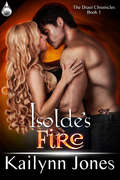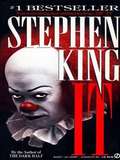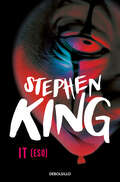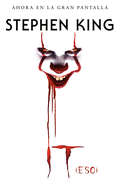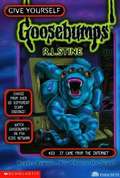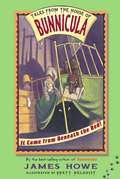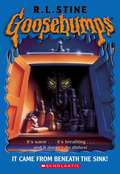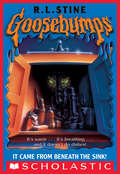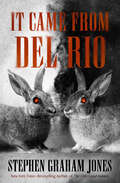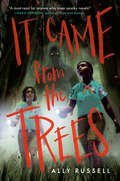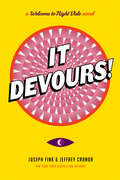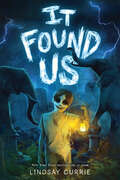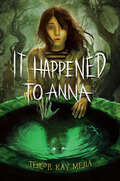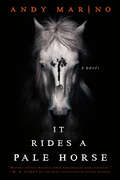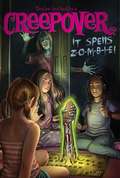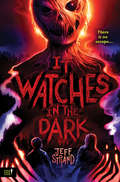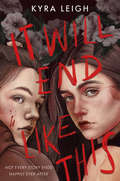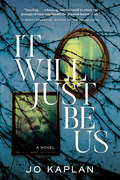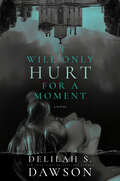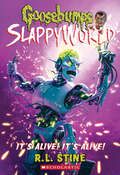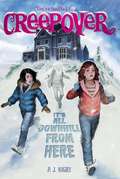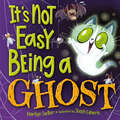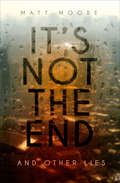- Table View
- List View
Isolde’s Fire
by Kailynn JonesSetting things on fire with an errant thought can really crimp a girl's social life. Now Izzy's destructive ability is exposed and she has to rely on Conlin, leader of Houston's supernaturals, to train her. But danger is stalking their world. Can Conlin teach her to control her abilities in time, or will evil strike first? So begins The Draoi Chronicles, the hot new romance series brought to you by Kailynn Jones. Isolde's Fire introduces you to a passion-filled world of magic, danger, and suspense. You won't be able to put this one down!Isolde "Izzy" Connors has melted one car door, fried five iPods, and singed her ponytail at least ninety-nine times over the last ten years. She doesn't know much about her power as a firestarter, just that it's one hell of an inconvenience. When her uncontrolled gift makes her a target, the Houston Collective of Magic Users swoops in to save the day, plunging Izzy into a shadow world she'd never dreamed of. She'll have to learn to trust the ragtag team of quirky supernaturals if she wants to survive. If only their smokin' hot leader weren't so arrogant, irritating, and overbearing.Thrust into command of the Houston Collective, Conlin is blindsided by Izzy, a fire affinity who could easily burn up the whole city if she doesn't learn to rein in her power. And she's come at the worst time. A rogue magic user is killing preternaturals, threatening the tenuous peace between the rival factions in the Bayou City. To solidify the alliance, Conlin will have to enlist the help of the local werewolf alpha, which rankles. But if he doesn't learn to balance his responsibilities and put old grievances behind him, his people might die...and so might Izzy.Content Notes: Spicy, Non-Sexual Graphic Violence, Paranormal, Magic, Wolves, Shifters, Witches, Wizardry, Suspense, Urban Fantasy
It
by Stephen King<P>Welcome to Derry, Maine...It's a small city, a place as hauntingly familiar as your own hometown. Only in Derry the haunting is real.... <P>They were seven teenagers when they first stumbled upon the horror. Now they are grown-up men and women who have gone out into the big world to gain success and happiness. <P>But none of them can withstand the force that has drawn them back to Derry to face the nightmare without an end, and the evil without a name. <P><b>A New York Times Bestseller</b>
It
by Stephen King¿Quién o qué mutila y mata a los niños de un pequeño pueblo norteamericano?¿Por qué llega cíclicamente el horror a Derry en forma de un payaso siniestro que va sembrando la destrucción a su paso? Esto es lo que se proponen averiguar los protagonistas de esta novela. Tras veintisiete años de tranquilidad y lejanía, una antigua promesa infantil les hace volver al lugar en el que vivieron su infancia y juventud como una terrible pesadilla. Regresan a Derry para enfrentarse con su pasado y enterrar definitivamente la amenaza que los amargó durante su niñez. Saben que pueden morir, pero son conscientes de que no conocerán la paz hasta que aquella cosa sea destruida para siempre. It es una de las novelas más ambiciosas de Stephen King, con la que ha logrado perfeccionar de un modo muy personal las claves del género de terror. La crítica ha dicho...«Insuperable.»La Vanguardia
It (Eso)
by Stephen KingAhora en español, nos llega esta escalofriante historia de Stephen King, clásico bestseller #1 del New York Times, "un punto de referencia en la literatura estadounidense" según el Chicago Sun-Times—sobre siete adultos que vuelven a su ciudad natal para hacerle frente a una pesadilla que vivieron cuando eran adolescentes...un mal sin nombre: Eso.Bienvenido a Derry, Maine. Es una ciudad pequeña, un lugar tan conmovedoramente familiar como tu propia ciudad natal. Solo que en Derry ocurren cosas muy extrañas. Eran siete adolescentes cuando conocieron el horror por primera vez. Ahora son hombres y mujeres adultos que han salido al mundo en búsqueda de éxito y felicidad. Pero la promesa que hicieran 28 años atrás los reúne en el mismo lugar donde enfrentaron, de adolescentes, a una criatura malvada que cazaba a los niños de la ciudad. Ahora hay niños asesinados nuevamente, y sus memorias reprimidas de aquel verano aterrador regresan mientras se preparan para enfrentar, una vez más, al monstruo escondido en las alcantarillas de Derry.
It (Eso)
by Stephen KingAhora en español, nos llega esta escalofriante historia de Stephen King, clásico bestseller #1 del New York Times, "un punto de referencia en la literatura estadounidense" según el Chicago Sun-Timessobre siete adultos que vuelven a su ciudad natal para hacerle frente a una pesadilla que vivieron cuando eran adolescentes...un mal sin nombre: Eso. Bienvenido a Derry, Maine. Es una ciudad pequeña, un lugar tan conmovedoramente familiar como tu propia ciudad natal. Solo que en Derry ocurren cosas muy extrañas. Eran siete adolescentes cuando conocieron el horror por primera vez. Ahora son hombres y mujeres adultos que han salido al mundo en búsqueda de éxito y felicidad. Pero la promesa que hicieran 28 años atrás los reúne en el mismo lugar donde enfrentaron, de adolescentes, a una criatura malvada que cazaba a los niños de la ciudad. Ahora hay niños asesinados nuevamente, y sus memorias reprimidas de aquel verano aterrador regresan mientras se preparan para enfrentar, una vez más, al monstruo escondido en las alcantarillas de Derry.
It Came From the Internet (Give Yourself Goosebumps #33)
by R. L. StineA creepy computer message just flashed on your screen. It says your web crawler has a virus. And if you don't get rid of it -- you'll catch the virus, too!<P><P> Hey! Look out! The web crawler is alive -- and crawling right out of your computer. It's sinking its fangs into you!<P> Now you've got the computer virus. And it's erasing your memory! Can you find a cure -- before you forget what is wrong with you? Should you trust a doctor who wants you to eat computer chips -- and dip? Or should you let a hacker take you on a virtual reality trip -- to Coffin City?<P> The choice is yours in this scary GOOSEBUMPS adventure that's packed with over 20 super-spooky endings!
It Came from Beneath the Bed! (Tales from the House of Bunnicula #1)
by James Howe Brett HelquistDear possible reader of this book,<P> I want to be a writer, just like my uncle Harold, who wrote a bunch of books about our friend Bunnicula. So I wrote this story. And boy! Did I ever get into trouble! My friend Delilah stopped speaking to me because I put her in my book. Uncle Harold stopped speaking to me because I didn’t put him in my book. A writer’s life isn’t easy!<P> But back to my story: It’s about how a talented and lovable (not to mention smart) wirehaired dachshund puppy named Howie saves the world from a disgusting, evil menace named...oops, that would give away the story. But trust me, this menace is disgusting and evil, all right!!!<P> Your friend, Howie
It Came from Beneath the Sink! (Goosebumps #30)
by R. L. StineKat and her little brother Daniel have just moved to a great new house. It would be perfect, if only their dog, Killer, would cheer up and stop growling at something under the kitchen sink. They soon discover that the dog has sniffed out something awful, something that could ruin their lives forever.
It Came from Beneath the Sink!: Monster Blood Iii; It Came From Beneath The Sink; Night Of The Living Dummy 2; The Barking Ghost (Goosebumps #30)
by R.L. StineFrom the New York Times–bestselling Goosebumps series, two siblings discover a monster lurking beneath the sink of their new house that preys on bad luck. Kat and her brother, Daniel, are so lucky. They just moved to a new house with tons of rooms, two balconies, and a lawn the size of a football field. But all that good luck is about to run out. Because there’s something really evil living in their new house. Something that’s moving. Watching. Waiting. Something that comes from beneath the kitchen sink. It might look like an ordinary sponge. But this scary creature doesn’t do dishes. . . .
It Came from Del Rio: A Bunnyhead Chronicle (The Bunnyhead Chronicles)
by Stephen Graham Jones&“Jones crosses into the noir badlands of No Country for Old Men—bloody and throwing sparks but cool as a killer angel—and by sundown he owns the joint.&” —Will Christopher Baer, author of Kiss Me, Judas Smuggler Dodd Raines just got the job of a lifetime. He&’ll finally earn enough money to secure a decent future for his young daughter and start over on the right side of the law. There&’s just one catch: his cargo is made up of moon rocks—with mass-casualty levels of radiation. Getting across the border from Mexico into the United States isn&’t easy, even though Raines has done it hundreds of times. If the blazing sun and hungry coyotes don&’t take him down, the border cop obsessed with catching him will. And then there are the moon rocks. No one delivering them is meant to survive—especially after already being killed. But that&’s the twist. One that transforms Raines into an undead rabbit-eared monster starving for vengeance, on a path straight into his orphaned daughter&’s life . . . &“A pitch-perfect noir tale of love and revenge.&” —The Denver Post &“No other writer could have done this. Period. Stephen Graham Jones has built a story out of radioactive scrap metal that anyone else would have rendered as kitsch. But with Jones, the diary of a rabbit-headed zombie chupacabra shepherd is absolutely convincing and utterly moving.&” —Craig Clevenger, author of Mother Howl and The Contortionist&’s Handbook
It Came from the Trees
by Ally RussellThe legend of Bigfoot gets a bone-chilling update in this scary story about a young girl and her scout troop who are willing to brave the woods to find her missing friend when no one else will. Perfect for fans of Daka Hermon and Claribel A. Ortega!The wilderness is in Jenna&’s blood. Her Pap was the first Black park ranger at Sturbridge Reservation, and she practically knows the Owlet Survival Handbook by heart. But she&’s never encountered a creature like the one that took her best friend Reese. Her parents don&’t believe her; the police are worthless, following the wrong leads; and the media isn&’t connecting the dots between Reese&’s disappearance and a string of other attacks. Determined to save her friend, Jenna joins a new local scout troop, and ventures back into the woods.When the troop stumbles across suspicious signs: huge human-like footprints near the camp, scratch marks on trees, and ominous sounds from the woods, Jenna worries that whatever took Reese is back to take her too. Can she trust her new scout leader? And will her new friend Norrie—who makes her laugh and reminds her so much of Reese—believe her?After the unthinkable happens, the scouts, armed with their wits and toiletries, band together to fight the monster and survive the night.
It Devours!: A Welcome to Night Vale Novel (Welcome to Night Vale #2)
by Joseph Fink Jeffrey Cranor<P>A new page-turning mystery about science, faith, love and belonging, set in a friendly desert community where ghosts, angels, aliens, and government conspiracies are commonplace parts of everyday life. <P>From the authors of the New York Times bestselling novel Welcome to Night Vale and the creators of the #1 international podcast of the same name, comes a mystery exploring the intersections of faith and science, the growing relationship between two young people who want desperately to trust each other, and the terrifying, toothy power of the Smiling God. <P>Nilanjana Sikdar is an outsider to the town of Night Vale. Working for Carlos, the town’s top scientist, she relies on fact and logic as her guiding principles. But all of that is put into question when Carlos gives her a special assignment investigating a mysterious rumbling in the desert wasteland outside of town. <P>This investigation leads her to the Joyous Congregation of the Smiling God, and to Darryl, one of its most committed members. Caught between her beliefs in the ultimate power of science and her growing attraction to Darryl, she begins to suspect the Congregation is planning a ritual that could threaten the lives of everyone in town. Nilanjana and Darryl must search for common ground between their very different world views as they are faced with the Congregation’s darkest and most terrible secret. <P><b>A New York Times Bestseller</b>
It Found Us
by Lindsay CurrieFrom the New York Times bestselling author of Scritch Scratch and The Girl in White comes a new spooky mystery about a girl detective who must decode a series of ominous clues tied to a century-old tragedy to find a missing teenager before it's too late…Twelve-year-old Hazel Woods has always had an unusual knack for sleuthing. Some may call it snooping, but all she really wants is to solve mysteries around town. So, when she not-so-accidentally overhears her brother Den planning to sneak into the cemetery at night for an epic game of hide-and-seek, she decides to secretly tag along. This seems like the perfect opportunity to investigate the claims that the cemetery is haunted.But the moment the game ends, Hazel realizes something is very, very wrong. From her hiding spot in the bushes, she overhears that her brother's best friend, Everett, is missing. Everyone else was found by the seeker but there's no sign of Everett anywhere. It's as if he just . . . vanishedHazel and Den are determined to find Everett before it's too late. But as they begin to unravel the terrifying clues that started appearing since that night in the graveyard–eerie whispers that sound like someone counting, the intermittent smell of smoke, and the cold, lost presence that follows them everywhere, she's not sure what they are dealing with. But Everett needs more than search parties and scent-tracking dogs to find him, especially if his disappearance is tied to the history of the cemetery, and the lost, century-old spirits that might still be trapped there . . .
It Happened to Anna
by Tehlor Kay MejiaThis spine-tingling ghost story follows a tween girl who&’s being literally haunted by loneliness until a new friendship upends her life. From the bestselling author of the Paola Santiago series!"Absolutely haunting!"—Delilah S. Dawson, New York Times bestselling author of MineSadie Rivera has been haunted all her life by a vengeful ghost—a ghost that doesn&’t want her to make any friends. The moment she tries? Cue exploding lightbulbs, chilling gusts of wind, and slamming doors.Last year, Sadie got fed up. Last year, she made a best friend, Anna. So when the ghost caused an accident that killed her best friend, Sadie knew it was all her fault.Which is why she&’s not going to make any friends this year at her new school. At least until mysterious cool girl Mal shows up, and the ghost doesn&’t bother her for once. But Mal wants Sadie all to herself—and she&’ll do anything to make sure it stays that way.
It Rides a Pale Horse
by Andy MarinoFrom a new star in horror fiction comes a terrifying novel of obsession, greed, and the shocking actions we&’ll take to protect those we love, all set in a small town filled with dark secrets. &“If you like Grady Hendrix&’s novels, Clive Barker, or just a dash of Lovecraftian horror, you&’re going to love this one.&” – San Francisco Book Review Peter Larkin — Lark to his friends — is a local hero in the small town of Wofford Falls. The one who went to the big city, found fame in the art world, then returned home to settle down. He's the kind of guy who becomes fast friends with almost anyone. His sister, Betsy, is talented as well. And eccentric. Unlike Lark, she keeps to herself. When Lark meets with a fabulously rich client, it seems like a regular transaction. Even being met at the gate of the sprawling, secluded estate by an intimidating security guard seems normal. Until the guard plays him a live feed: Betsy being abducted in real time. Lark is informed that she's safe for now, but her well-being is entirely in his hands. He's given a book. Do what the book says, and betsy will go free."Marino draws readers in quickly, creating sympathy for the characters, unveiling the necessary details to immerse them in a world of art, siblings, deadly intrigue, and a centuries-long nefarious quest. Dread is present from the start, but it quickly escalates into a disorienting cosmic terror that touches everyone." — Booklist"Marino offers horrors both existential and visceral." — M. R. Carey, author of The Girl with All the Gifts, on The Seven Visitations of Sydney Burgess"Dark and fascinating . . . Not quite like anything I've ever read before. A strange, compelling, late-night page-turner. It kept me reading way past my bedtime." —T. Kingfisher, author of The Hollow Places, on The Seven Visitations of Sydney BurgessAlso by Andy Marino:The Seven Visitations of Sydney Burgess
It Spells Z-O-M-B-I-E!
by P. J. NightDon’t miss the frights and fun at a Halloween sleepover you’ll never forget in this scary Creepover tale.Abby Miller is having a Halloween sleepover with her best friends. They’ll go trick-or-treating and then come back to Abby’s house to discover their destinies on her spirit board. But the prophecy the board tells Abby and her friends has nothing to do with crushes, grades, or even the distant future. Instead, the board spells out a warning: Z-O-M-B-I-E. Zombies are real…and they are coming for them! This terrifying tale is rated a Level 5 on the Creep-O-Meter.
It Watches in the Dark (Eek!)
by Jeff Strand"She glanced over her shoulder. Had the scarecrow moved? It stood there, smile stitched on its face, but now it felt like a smirk."Prepare to be scared silly in this creepy middle-grade novel! Twins seek medical help in a remote village after their father is in a canoeing accident...only to discover the scarecrow that stands watch in town may have a stronger hold over the residents than expected. Perfect for fans of R.L. Stine, Dan Poblocki, and Mary Downing Hahn.Twins Oliver and Trisha love going on adventures with their dad. Canoeing and camping on the Champion River will be their best trip yet! But when they capsize in rapids, their father is knocked unconscious. Alone and without cell phone reception, their only choice is to continue down river for help.Hours of paddling brings them to an old dock, and a narrow path leads them to a small village. The townspeople are kind and helpful, but strangely focused on the giant scarecrow in the village square. "He watches over us," the twins are told in whispers. "He keeps us safe."An old woman warns the twins not to spend the night in the village. Not if they ever want to leave. But with the sun soon to set and their father not well enough to be moved, how can they escape? More importantly, can they survive?
It Will End Like This
by Kyra Leigh"If you think you know how this one will end, I promise, you don't." —Kara Thomas, author of That Weekend and The CheerleadersFor fans of They Wish They Were Us and Sadie comes a propulsive thriller that reminds us that in real life, endings are rarely as neat as happily ever after. A contemporary take on the Lizzie Borden story that explores how grief can cut deep.Charlotte lost her mother six months ago, and still no one will tell her exactly what happened the day she mysteriously died. They say her heart stopped, but Charlotte knows deep down that there's more to the story. The only person who gets it is Charlotte's sister, Maddi. Maddi agrees—people&’s hearts don&’t just stop. There are too many questions left unanswered for the girls to move on. But their father is moving on. With their mother&’s personal assistant. And both girls are sure of one thing: she's going to steal everything that's theirs for herself. She'll even get rid of them eventually. Now, in order to get their lives back, Charlotte and Maddi have to decide what kind of story they live in. Do they remain the obedient girls their father insists they be, or do they follow their rage to the end?
It Will Just Be Us: A Novel
by Jo KaplanA terrifying new gothic horror novel about two sisters and a haunted house that never sleeps, perfect for fans of Shirley Jackson's We Have Always Lived in the Castle.They say there's a door in Wakefield that never opens... Sam Wakefield's ancestral home, a decaying mansion built on the edge of a swamp, isn't a place for children. Its labyrinthine halls, built by her mad ancestors, are filled with echoes of the past: ghosts and memories knotted together as one. In the presence of phantoms, it's all Sam can do to disentangle past from present in her daily life. But when her pregnant sister Elizabeth moves in after a fight with her husband, something in the house shifts. Already navigating her tumultuous relationship with Elizabeth, Sam is even more unsettled by the appearance of a new ghost: a faceless boy who commits disturbing acts--threatening animals, terrorizing other children, and following Sam into the depths of the house wielding a knife. When it becomes clear the boy is connected to a locked, forgotten room, one which is never entered, Sam realizes this ghost is not like the others. This boy brings doom... As Elizabeth's due date approaches, Sam must unravel the mysteries of Wakefield before her sister brings new life into a house marked by death. But as the faceless boy grows stronger, Sam will learn that some doors should stay closed--and some secrets are safer locked away forever.
It Will Only Hurt for a Moment: A Novel
by Delilah S. DawsonIn this highly atmospheric thriller from the Bram Stoker Award–nominated author of The Violence, a young woman hopes to reinvent herself at an isolated artists&’ colony . . . only to be drawn into its dark, twisted past.&“Filled to the brim with righteous fury and fright that cannot be quelled, this novel solidifies Dawson as an unstoppable force.&”—Clay McLeod Chapman, author of What Kind of Mother and Ghost EatersSarah Carpenter is starting over. She&’s on the run—leaving behind her unsupportive, narcissistic ex-boyfriend and alcoholic, abusive mother—and headed for a new beginning at Tranquil Falls, a secluded artists&’ colony on the grounds of a closed hotel. There, with no cell signal or internet to distract her, she hopes to rediscover her love for pottery and put the broken pieces of her life back together. But when Sarah uncovers the body of a young woman while digging a hole for a pit kiln, things start to fall apart. Her fellow artists begin to act in troubling ways. The eccentric fiber artist knits an endless scarf. The musician plays the same carousel song over and over until his fingers bleed. The calligrapher grins with ink-stained teeth. Not to mention the haunting dreams Sarah has night after night. When she discovers glass shards in her clay, Sarah wonders if someone is out to get her—or if she&’s losing her grip on reality out here in the wilds, where the pounding of the waterfall never, ever fades. As she investigates the beautiful valley and the crumbling resort looming over them all, she unearths a chilling past that refuses to remain buried . . .
It's Alive!
by Richard WoodleyLenore and Frank Davis were a loving family, looking forward to their new baby, but it was a grotesque mutation, a tiny rampaging aberration.
It's Alive! It's Alive! (Goosebumps SlappyWorld #7)
by R. L. StineGoosebumps now on Disney+!Livvy and Jayden are the stars of their school's robotics team. Livvy is especially enthusiastic because her own mother works in a robotics lab and experiments with Artificial Intelligence. To impress her mom, Livvy and Jayden build a robot. Livvy wants to name their robot "Francine," but Jayden thinks that's too silly for their creation. Desperate to win, Livvy and Jayden "borrow" an Artificial Intelligence module. They soon realize they've made a terrible mistake. Francine has too much brain power. She's alive! And using this newly gained brain power to dream up a deadly contest!
It's All Downhill from Here
by P. J. NightThis is one ghost who is determined to get his way...no matter what the price.Maggie Kim's parents have always dreamed of operating their own hotel, so when the historic Wharton Mansion goes up for sale, they see it as the perfect opportunity to open their own ski lodge. This weekend, Maggie and her family are going to check the place out and perhaps even buy it on the spot. But Maggie doesn't want to move to a run-down old mansion all the way up on a desolate mountain--and the ghost that lives there doesn't want her there either . . . a ghost that will stop at nothing to get his way.This haunting horror story is rated a Level 4 on the Creep-o-Meter.
It's Not Easy Being A Ghost (It's Not Easy Being)
by Marilyn SadlerLife isn't always easy—even for a ghost! In this funny follow-up to It's Not Easy Being Santa Claus, a ghost discovers that happiness comes from within when she learns to accept that she's simply too cute to be considered spooky! The perfect way to celebrate Halloween with your littlest trick or treaters!Misty the Ghost is feeling sad. The haunted house she lives in is cold and damp. Spiders have taken over her living room. And worst of all, nobody thinks she is spooky. They think she is (gasp!) CUTE. But after trying to disguise herself as a mummy, a werwolf, and a witch—with hilarious results—Misty learns that true happiness comes from just being herself.Featuring a comical cast of animal characters—plus a little bat sidekick with a BIG attitude for readers to find hidden on every page—this hardcover picture book about self-acceptance and overcoming obstacles makes a sweet Halloween treat for young readers!Everyone has a rough day now and then and wishes they could do something or be someone else. Not even beloved characters like Santa Claus, ghosts, and leprechauns are immune! The It's Not Easy... picture book series explores the witty ways these iconic holiday and seasonal characters search for happiness, only to find it within themselves.Also available:It's Not Easy Being Santa Claus Coming soon:It's Not Easy Being a Leprechaun
It's Not the End: And Other Lies
by Matt Moore“Moore is a gardener of nightmares, artlessly turning over the dark soil in which the horrors that entangle ordinary people in their killing grasp bloom” (Michael Rowe, award-winning author of October). All these worlds, and more, await you . . . Only able to recall the memories of others, a ghost must solve the mystery of his own death. The zombie apocalypse is the gateway to a higher human consciousness. An amusement park of the future might turn you into the attraction. An engineer-turned-mercenary races to kill the savior of mankind. After the sky falls, can anyone still hope? Twenty-one horror and science fiction tales of the bizarre, the terrifying, the all-too-near future. “Subtle power, intelligence, and humanity are the hallmarks of Moore’s work. These stories are apt to stick in your mind like quills. They did in mine.”—Nick Cutter, national bestselling author of The Troop “Moore takes us on a multitude of wild rides. If there is one thing I can say about these, it’s that they are action-packed . . . Moore is also very good at wrenching emotion out of his readers, whether abject horror or discomfort, the effect is visceral and real.” —The Ottawa Review of Books “Like the best science fiction or horror writers out there, Moore’s talent doesn’t stop at combining the everyday with the speculative—the real magic is his character work.” —Black Gate
